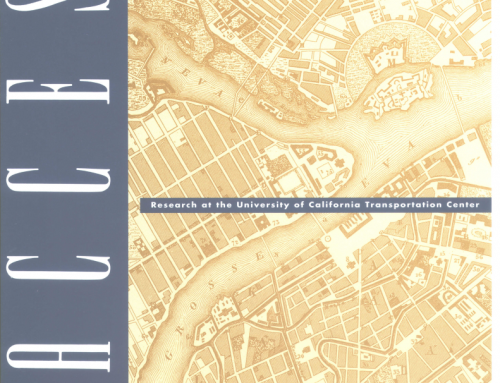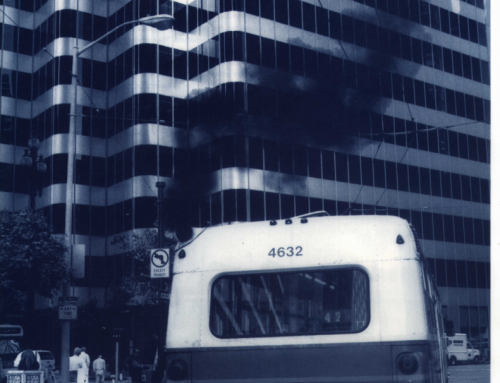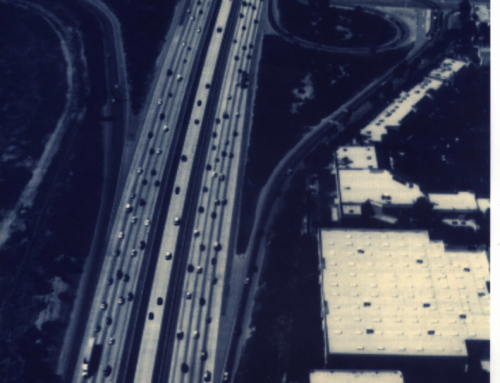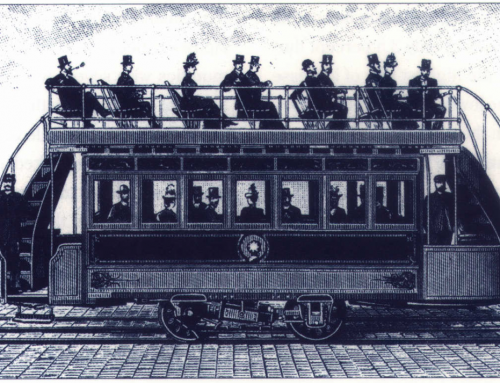Much of transportation planning and engineering today aims at reducing average delays, increasing passenger throughput, and in general keeping traffic flowing smoothly and safely. These are the field’s principal measure of performance. But is a quick, uncongested trip indicative of a well-planned, accessible community?
It is axiomatic, yet worth repeating, that the physical act of traveling is a derived behavior. People travel to engage in activities at other places – work, recreation, shopping, worship, health care, and so on – not because they wish to ride a car or bus. We must distinguish between accessibility, which relates to people’s opportunities to get where they want to go, and mobility, which relates to the ease of actually traveling between two or more points. Accessible neighborhoods are those within easy reach of desired destinations either because they are located nearby or because transit and highway connections are fast and direct. Improvements in accessibility should focus on people, places, and social activities, not the transportation system itself.
People often misunderstand the concept of “accessibility,” which may partly explain why expanded access is seldom an explicit objective in transportation planning. In contrast, mobility, or the lack thereof, is something that we all regularly experience firsthand.
The term “accessibility” has various meanings depending on one’s scale of analysis. Within a metropolitan context, accessibility relates to opportunities to reach places across a region. Those preparing long-range metropolitan transportation plans deal with regional accessibility. But at a micro-level, site accessibility refers to the relative ease of gaining entry to a specific destination. For example, a road with multiple curb cuts provides ready access to adjacent parcels, thereby increasing site accessibility; at the same time, such a road decreases mobility, since frequent ingress-egress maneuvers often interfere with traffic. Transportation modes and facilities themselves also affect site accessibility. Thus, traffic engineers distinguish highways that have limited access, such as those restricted to grade-separated interchanges, from those having unconstrained access. All federally funded transit projects must be fully accessible to disabled persons under the Americans with Disabilities Act, which means providing accommodations such as low-floor buses and rail stations with ramps and elevators.
In this article I’m using the term accessibility in its regional context, that is, residents’ opportunities to reach major destinations across a metropolis. Today, few if any American metropolitan areas are systematically tracking trends in regional accessibility and it remains unclear whether decisions on resource allocation – e.g., whether to expand a road’s capacity, where to site a major new shopping center – are helping to improve transportation efficiency. It is also unclear how different socio-economic groups are affected by investment decisions: Who gains or loses access to job opportunities following construction of a new rail system? When big companies change work locations, are various groups affected differently?
Some scholars argue that a root cause of joblessness and persistent poverty is the increasing physical isolation of inner-city residents, especially African-Americans, who lack transportation to job opportunities in the suburbs. They call this the “spatial mismatch” problem. These concerns prompted the federal government to initiate the “Bridges to Work” program in 1996, a welfare-to-workfare movement in which reverse-commute van services link tens of thousands of inner-city residents to suburban jobs in Baltimore, Milwaukee, and about a dozen other US cities.
JOB ACCESSIBILITY IN THE SAN FRANCISCO BAY AREA
As part of a study designed to operationalize the use of accessibility as a measure of transportation performance, students at UC-Berkeley and I examined trends in regional accessibility within the San Francisco Bay Area. We examined only one type of destination – the workplace. Our study traced changes in regional accessibility to jobs between 1980 and 1990 across a sample of 100 neighborhoods in the nine-county Bay Area. We hoped to demonstrate how different measures of job accessibility can be used to track system performance in long-range transportation-land use planning. We also sought to assess whether the spatial mismatch hypothesis holds in the Bay Area.
Using Census data, we developed job-accessibility indices that weighed the relative distances, expressed in miles, of working-age residents in each of 100 sampled neighborhoods to regional job opportunities, assuming trips were made by car over the regional highway network. We did not study accessibility by transit, nor did we adjust for variability in car ownership since over 92 percent of households in the surveyed census tracts owned one or more cars. We refined in our study to account for the degree to which the occupational backgrounds and skills of residents ![]() matched up with the kinds of jobs available in each of the Bay Area’s 1382 Census tracts. The resulting “accessibility scores” were standardized so that job-accessibility of each neighborhood could be compared to the regional average. An accessibility score of +2, for example, indicates that a neighborhood is considerably more accessible to job opportunities, accounting for the degree of occupational matching, than that of the average working-age Bay Area resident.
matched up with the kinds of jobs available in each of the Bay Area’s 1382 Census tracts. The resulting “accessibility scores” were standardized so that job-accessibility of each neighborhood could be compared to the regional average. An accessibility score of +2, for example, indicates that a neighborhood is considerably more accessible to job opportunities, accounting for the degree of occupational matching, than that of the average working-age Bay Area resident.
In both 1980 and 1990, the neighborhoods most accessible to jobs, were those located in central areas: San Francisco, the older parts of the East Bay (Oakland and Berkeley), and northern Santa Clara County, around the Silicon Valley. Most of these neighborhoods averaged job-accessibility scores of 0.7 to 1.5, well above the regional average of zero. Peripheral neighborhoods, specifically those in Santa Rosa and Vacaville in the North Bay and Morgan Hill in the far South Bay, tended to be the least job-accessible. Their accessibility scores were in the range of -2 to -3. Figure 1 maps the 1980 and 1990 scores for all 100 sampled neighborhoods. The real value in these numbers lies in their comparisons with other neighborhoods’ scores. The Bay Area’s more centralized neighborhoods are three to four times more accessible to job opportunities than peripheral ones.
Underlying these fairly straightforward findings, however, are two alarming patterns. First, disparities widened during the 1980s. Between 1980 and 1990, the most job-accessible (i.e., central) neighborhoods experienced the greatest gains in accessibility, while the least job-accessible (i.e., peripheral) ones suffered the largest losses. This occurred despite rapid suburbanization of jobs during the 1980s. Second, well-to-do neighborhoods were generally much more accessible to jobs for which their residents were qualified than were poorer neighborhoods. Thus, our measure of “match effect” – the relative importance of occupational matching toward a high job-accessibility score -was strongly associated with income and race. In 1990, the ten neighborhoods with the highest match effect averaged annual household incomes of over $80,000, well above the regional average. The same ten neighborhoods averaged an unemployment rate of less than 3 percent, compared to a regional 7 percent average. In contrast, the greatest job-opportunity mismatches were in the region’s poorest neighborhoods – San Francisco’s Tenderloin and Mission districts, East Oakland, and East Palo Alto.
These findings likely reflect several dynamics. Many service-industry, manufacturing, and back-office jobs left central cities during the 1980s. The well-educated, high-salary workers could more easily move to neighborhoods reasonably close to desirable jobs for which they were qualified. For example, Russian Hill in San Francisco, which recorded the highest match effect in 1990, attracted hundreds of executives and highly paid young professionals seeking both urbanity and close proximity to front-office jobs in downtown San Francisco. Also, leading Bay Area firms tended to locate near potential pools of professional and executive workers during the 1980s. However, because of factors such as exclusionary zoning and housing discrimination, poorer households stuck in often declining inner-city neighborhoods found it increasingly difficult to access jobs for which they were qualified during the 1980s.
UNEMPLOYMENT: RACE VERSUS SPACE
The spatial mismatch hypothesis is highly controversial because empirical evidence is inconsistent. A late-1980s study in Los Angeles found that job accessibility accounted for 30 to 50 percent of the difference in employment rates among black and white teenagers. Others counter that overt racial discrimination, not accessibility, largely explains inner-city unemployment. In an influential study of black households in Chicago, David Ellwood of Harvard’s Kennedy School found comparably high unemployment rates among blacks with similar education levels regardless of whether they resided on the southside, away from job opportunities, or west of the city near the booming Interstate 88 employment corridor. He concluded that “race, not space” was the chief reason for chronic unemployment among blacks.
Our data allows us to address the “race versus space” controversy for the Bay Area. Using a statistical technique called path analysis, we explored![]() how the racial composition of a neighborhood affects unemployment rates, accounting for job-accessibility, occupational matching, educational level, and automobile ownership.
how the racial composition of a neighborhood affects unemployment rates, accounting for job-accessibility, occupational matching, educational level, and automobile ownership.
Ideally we’d have found the correlation between race and unemployment spurious. We hoped to find little difference in joblessness among racial groups. That is, if race doesn’t matter, employment rates would be comparable among 100 African-Americans and 100 whites with similar educational backgrounds and car ownership levels, who live in neighborhoods with similar levels of job accessibility.
We found a statistical correlation of +0.757 between percent of households that are African-American and civilian unemployment rates for the 100 sampled Bay Area neighborhoods. Only 4 percent of the association was attributable to blacks being less accessible than whites to jobs, while not having access to a car explained just 5 percent of the association. A larger part of the association, 33 percent, could be explained by the lower average-level of educational attainment among African-Americans. But race directly accounted for 58 percent of the correlation. Thus while “space,” or job accessibility, does matter in explaining black unemployment in the San Francisco Bay Area, race and educational attainment appear to matter much more. These findings clearly side with “race” more than with “space” in explaining joblessness in the region, at least among African-Americans.
ELEVATING ACCESSIBILITY IN PLANNING PRACTICE
While our findings suggest that inaccessibility to jobs is not a major factor in explaining Bay Area black unemployment, this does not diminish the importance of measuring and tracking accessibility over time. We were able to isolate the relative statistical importance of race in explaining black unemployment only by having a refined measure of accessibility that controlled for occupational matching. We had to control for the effects of “space” to understand the effects of “race.” Moreover, our analysis traced only one dimension of accessibility- regional access to jobs.
Tracing trends in access to hospitals and medical clinics might reveal, for instance, whether new transit investments and changing urbanization patterns are making certain groups, like seniors, more or less accessible to available health-care services. Longitudinal studies of shifting levels of regional accessibility might prove valuable in other policy realms. By associating shifts in regional accessibility to changes in VMT per capita, air-quality planners could determine the importance of land-use management in reducing mobile-source emissions.
To date, the Netherlands has progressed furthest in reforming regional transportation planning to emphasize both accessibility and mobility. Dutch planners draw mobility profiles for new businesses, defining the amount and type of traffic likely to be generated. They classify various locations within a city according to their accessibility levels. For example, locations that are well-served by public transit, that are connected to nearby neighborhoods by bike paths, and that have a variety of retail shops receive high accessibility marks. Thus they are targeted for land uses that generate steady traffic streams, e.g., college campuses, commercial plazas, public offices. More remote areas that can be conveniently reached only by motorized transport tend to be assigned land uses that need not be easily accessible by the general public, e.g., warehouses and factories.
One reason accessibility issues have failed to garner much political attention elsewhere may be that those who are least accessible also wield the least political clout. Accessibility also does not resonate as a particularly important political issue because it is not an easy concept for laypeople to grasp. Further, the sparsity of empirical research and evidence linking accessibility to broader social agendas probably reflects a built-in resistance to changing methodological approaches. This undoubtedly impedes the evolution of accessibility as a performance measure.
Traditional performance indicators fail to reflect the vital role of land-use patterns in making cities and regions more accessible. Accessible regions are those that allow more time to be spent at desired destinations than on the road. This might be accomplished by bringing activities closer together, by designing walkable communities, or by promoting tele-work. Only by tracking changes in accessibility over time will we be in a position to gauge whether unfolding patterns of urban growth are working to make destinations easier or more difficult to reach. Expanding the use of accessibility as a performance indicator and making clear connections between accessibility and real-world problems, I conclude, are important challenges that the transportation planning profession must be prepared to take on.
Further Readings
Cervero, Robert, Timothy Rood, and Brue Appleyard, “Job Accessibility as a Performance Indicator: An Analysis of Trends and their Social Policy Implications in the San Francisco Bay Area,” Working Paper 692, Institute of Urban and Regional Development, University of California, Berkeley, 1997.
Ellwood, David, “The Spatial Mismatch Hypothesis: Are There Teenage Jobs Missing in the Ghetto?” Black Youth Employment Crisis, R. Freeman and H. Holzer, Eds., pp. 147-190 (Chicago: University of Chicago Press, 1986).
Ihlandfeldt, Keith and Sjoquist, David, “The Impact of Job Decentralization on the Economic Welfare of Central City Blacks,” Journal of Urban Economics, vol. 26, 1989, pp. 110-130.
Kain, John, “The Spatial Mismatch Hypothesis: Three Decades Later,” Housing Policy Debate, vol. 3, 1993, pp. 371-460.
Pirie, G., “The Possibility and Potential of Public Policy on Accessibility.” Transportation Research, vol. 9A, 1981, pp. 145-172.
Wachs, Martin and Kumagal, T., “Physical Accessibility as a Social Indicator,” Socio-Economic Planning Science, vol. 6, 1973, pp. 357-379.





